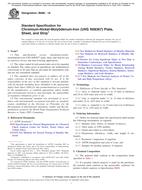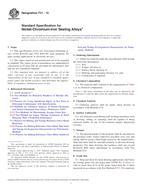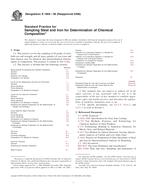1.1 This practice relates to the multivariate calibration of spectrometers and spectrophotometers used in determining the physical and chemical characteristics of materials. A detailed description of general multivariate analysis is given in Practice E1655. This standard refers only to those instances where surrogate mixtures can be used to establish a suitable calibration matrix. This practice specifies calibration and qualification data set requirements for interlaboratory studies (ILSs), that is, round robins, of standard test methods employing surrogate calibration techniques that do not conform exactly to Practices E1655.
Note 1–For some multivariate spectroscopic analyses, interferences and matrix effects are sufficiently small that it is possible to calibrate using mixtures that contain substantially fewer chemical components than the samples that will ultimately be analyzed. While these surrogate methods generally make use of the multivariate mathematics described in Practices E1655, they do not conform to procedures described therein, specifically with respect to the handling of outliers.
1.2 This practice specifies how the ILS data is treated to establish spectrometer/spectrophotometer performance qualification requirements to be incorporated into standard test methods.
Note 2–Spectrometer/spectrophotometer qualification procedures are intended to allow the user to determine if the performance of a specific spectrometer/spectrophotometer is adequate to conduct the analysis so as to obtain results consistent with the published test method precision.
1.2.1 The spectroscopies used in the surrogate test methods would include but not be limited to mid- and near-infrared, ultraviolet/visible, fluorescence and Raman spectroscopies.
1.2.2 The surrogate calibrations covered in this practice are: multilinear regression (MLR), principal components regression (PCR) or partial least squares (PLS) mathematics. These calibration procedures are described in detail in Practices E1655.
1.3 For surrogate test methods, this practice recommends limitations that should be placed on calibration options that are allowed in the test method. Specifically, this practice recommends that the test method developer demonstrate that all calibrations that are allowed in the test method produce statistically indistinguishable results.
1.4 For surrogate test methods that reference spectrometer/spectrophotometer performance practices, such as Practices E275, E387, E388, E579, E925, E932, E958, E1421, E1683, E1866 or E1944, this practice recommends that instrument performance data be collected as part of the ILS to establish the relationship between spectrometer/spectrophotometer performance and test method precision.
Product Details
- Published:
- 11/01/2004
- Number of Pages:
- 10
- File Size:
- 1 file , 120 KB
- Redline File Size:
- 2 files , 220 KB


